Potential Issues of Flushing Cat Poop Down Your Toilet - Safeguard Your Plumbing
Potential Issues of Flushing Cat Poop Down Your Toilet - Safeguard Your Plumbing
Blog Article
Do you find yourself trying to find help and advice Can You Flush Cat Poop Down The Toilet??

Intro
As pet cat proprietors, it's important to bear in mind just how we throw away our feline buddies' waste. While it may appear convenient to flush feline poop down the commode, this technique can have destructive effects for both the environment and human health.
Alternatives to Flushing
Fortunately, there are safer and extra responsible methods to take care of feline poop. Take into consideration the complying with alternatives:
1. Scoop and Dispose in Trash
One of the most common approach of disposing of cat poop is to scoop it into a biodegradable bag and toss it in the trash. Make certain to use a committed trash inside story and get rid of the waste immediately.
2. Usage Biodegradable Litter
Choose biodegradable pet cat litter made from materials such as corn or wheat. These trashes are environmentally friendly and can be securely dealt with in the trash.
3. Hide in the Yard
If you have a lawn, take into consideration hiding pet cat waste in a marked area away from veggie gardens and water sources. Make certain to dig deep sufficient to avoid contamination of groundwater.
4. Mount a Pet Waste Disposal System
Invest in an animal waste disposal system especially created for feline waste. These systems utilize enzymes to break down the waste, minimizing odor and environmental influence.
Health Risks
Along with environmental issues, flushing feline waste can likewise pose wellness dangers to humans. Feline feces might include Toxoplasma gondii, a bloodsucker that can trigger toxoplasmosis-- a possibly serious ailment, specifically for expectant females and individuals with damaged body immune systems.
Ecological Impact
Flushing feline poop presents hazardous virus and parasites right into the water, presenting a considerable danger to marine ecological communities. These contaminants can negatively affect marine life and concession water high quality.
Conclusion
Liable animal ownership expands beyond offering food and sanctuary-- it also involves appropriate waste monitoring. By refraining from flushing cat poop down the toilet and selecting alternative disposal methods, we can decrease our environmental impact and safeguard human health.
Why Can’t I Flush Cat Poop?
It Spreads a Parasite
Cats are frequently infected with a parasite called toxoplasma gondii. The parasite causes an infection called toxoplasmosis. It is usually harmless to cats. The parasite only uses cat poop as a host for its eggs. Otherwise, the cat’s immune system usually keeps the infection at low enough levels to maintain its own health. But it does not stop the develop of eggs. These eggs are tiny and surprisingly tough. They may survive for a year before they begin to grow. But that’s the problem.
Our wastewater system is not designed to deal with toxoplasmosis eggs. Instead, most eggs will flush from your toilet into sewers and wastewater management plants. After the sewage is treated for many other harmful things in it, it is typically released into local rivers, lakes, or oceans. Here, the toxoplasmosis eggs can find new hosts, including starfish, crabs, otters, and many other wildlife. For many, this is a significant risk to their health. Toxoplasmosis can also end up infecting water sources that are important for agriculture, which means our deer, pigs, and sheep can get infected too.
Is There Risk to Humans?
There can be a risk to human life from flushing cat poop down the toilet. If you do so, the parasites from your cat’s poop can end up in shellfish, game animals, or livestock. If this meat is then served raw or undercooked, the people who eat it can get sick.
In fact, according to the CDC, 40 million people in the United States are infected with toxoplasma gondii. They get it from exposure to infected seafood, or from some kind of cat poop contamination, like drinking from a stream that is contaminated or touching anything that has come into contact with cat poop. That includes just cleaning a cat litter box.
Most people who get infected with these parasites will not develop any symptoms. However, for pregnant women or for those with compromised immune systems, the parasite can cause severe health problems.
How to Handle Cat Poop
The best way to handle cat poop is actually to clean the box more often. The eggs that the parasite sheds will not become active until one to five days after the cat poops. That means that if you clean daily, you’re much less likely to come into direct contact with infectious eggs.
That said, always dispose of cat poop in the garbage and not down the toilet. Wash your hands before and after you clean the litter box, and bring the bag of poop right outside to your garbage bins.
https://trenchlesssolutionsusa.com/why-cant-i-flush-cat-poop/

Do you really like reading about How to Dispose of Cat Poop and Litter Without Plastic Bags? Make a short review down below. We would be glad to find out your opinion about this article. Hoping to see you back again later on. If you please take the time to share this article if you appreciated it. Thanks a lot for your time. Kindly check up our website back soon.
Call Today Report this page